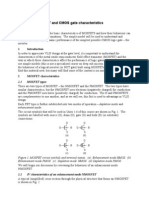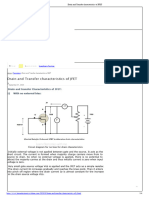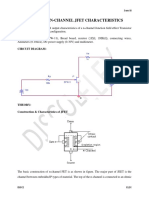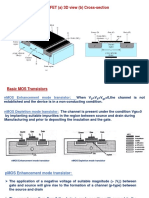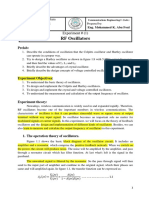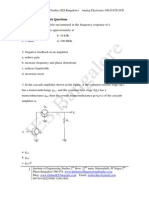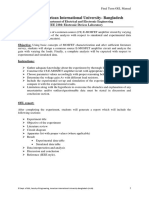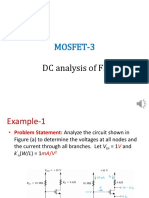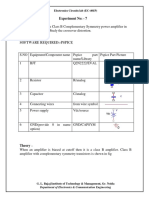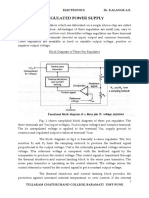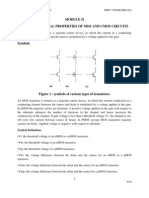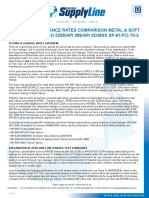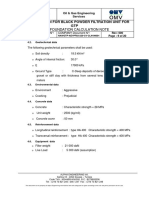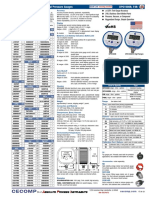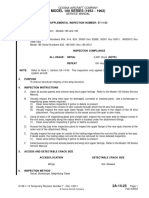MOS DEVICE FUNDAMENTALS
Professor A. K. Majumdar
Computer Science and Engineering Department Indian Institute of Technology, Kharagpur
MOS-SLIDES-AKM
�Metal-Oxide Semiconductor (MOS) Field Effect Transistors
NMOS enhancement mode transistor
MOS-SLIDES-AKM 2
�Induced Channel in NMOS Transistor
Enhancement mode NMOS transistor with VGS>0 showing induced channel
MOS-SLIDES-AKM 3
�Current Voltage characteristics of NMOS transistors
MOS-SLIDES-AKM
�NMOS Transistor Analysis
Induced Channel Charge / Unit Area Q(x) = - COX [ VGS V(x) Vth] Where COX = OX/ tOX capacitance per unit area due to gate oxide Drain current IDS = vn(x) Q(x)W vn(x) = drift velocity of electron
MOS-SLIDES-AKM
�NMOS Transistor Analysis Contd
vn(x) = - n E(x) = n dV/dx n = Mobility of electrons Hence IDS = - n Q(x)W dV/dx Substituting for Q(x), IDS dx = n COX W[VGS V(x) Vth] dV Integrating IDS= n COX W/L[(VGS - Vth ) - VDS /2 ] VDS IDS = n [(VGS - Vth ) - VDS /2 ] VDS
MOS-SLIDES-AKM 6
�NMOS Transistor Analysis in Linear Region
kn =n COX = n OX/ tOX is called process transconductance parameter n = kn(W/L) is called gain factor For small VDS , VDS2 /2 can be ignored and IDS depends linearly on VDS Rlinear = 1/ (n (VGS - Vth))
MOS-SLIDES-AKM
�NMOS Transistor Analysis in Linear Region
Transconductance of NMOS transistor gm = (dIDS/ dVGS) VDS = constant In linear region gm = n VDS
MOS-SLIDES-AKM
�NMOS Transistor Analysis Saturation Region
VDS VGS Vth Channel is pinched off Assuming voltage difference over induced channel from source to pinch off point fixed at VGS Vth IDS = n /2 (VGS Vth)2 In saturation region, MOS transistor acts as a constant current source. Transconductance in saturation region gm = n (VGS Vth)
MOS-SLIDES-AKM 9
�Current Voltage Relationship of NMOS Transistor
The drain-to-source current-voltage dependence for a NMOS transistor is given by the following equations
IDS = 0 IDS = n/2.(VGS Vth)2 for VDS < Vth (off) for 0 < VDS Vth < VDS (saturation)
IDS = n(VGS Vth VDS/2)VDS for VGS > Vth and VGS Vth VDS (linear) n = (nox/tox).W/L
where n is the mobility of electron, ox is the permittivity of the oxide material, and tox is the thickness of the oxide.
MOS-SLIDES-AKM 10
�Channel Length Modulation
In saturation region, the transistor does not operate as a perfect current source, i.e. IDS is not independent of VDS As VDS is increased beyond (VGS Vth) effective channel length decreases. Since IDS 1/L, reduction in effective channel length increases IDS More accurate representation IDS = n/2.(Vgs Vth)2 ( 1 + VDS)
MOS-SLIDES-AKM 11
�Current Voltage Relationship of PMOS Transistor
Cut off VGS > Vth IDS = 0 Linear Region: VGS Vth and VDS > VGS Vth IDS = p(VGS Vth VDS/2)VDS Saturation region VGS Vth, and VDS < VGSVth IDS = p/2.(VGSVth)2 where the gain factor p = (pox/tox).W/L and p is mobility of holes
MOS-SLIDES-AKM 12
�Velocity Saturation
Electron mobility cannot be considered to be constant with increasing electric field For short channel devices velocity saturates
MOS-SLIDES-AKM
13
�Velocity saturation effect
Let VDSAT : drain-source voltage at which the critical field for velocity saturation is reached First order approximation: For VDS < VDSAT, IDS expression is similar to long channel model For VDS VDSAT IDS =IDSAT = SAT Cox W [ VGS Vth VDSAT/2 ] Where SAT = VDSAT / L is the saturation velocity
MOS-SLIDES-AKM 14
�MOS Transistor Threshold Voltage
Depletion region charge density - due to fixed acceptor ions in the p-type substrate:
Qdep = 2q si N AVdep
where, Vdep is the voltage across the depletion layer at the oxide silicon boundary Channel inversion occurs when Vdep = 2F where the Fermi potential F = kT/q ln( NA/ ni) F -0.3 V for nMOS
MOS-SLIDES-AKM 15
�Threshold Voltage
At strong inversion depletion layer charge density:
Qdep = 2qsi NA (| 2F +VSB |)
Where VSB is the substrate bias With zero substrate bias, threshold voltage Vth0 = GC -2 F - Qdep / Cox - Qi / Cox where is GC the work function difference between the gate and substrate (flat band voltage) and Qi is due to impurities at the interface between the gate oxide and silicon substrate
MOS-SLIDES-AKM
16
�Threshold Voltage
Threshold voltage with non-zero substrate bias
V =V 0 + | 2F +V | | 2F | th th SB
where the parameter is called bodyeffect (substrate bias) coefficient.
MOS-SLIDES-AKM
17
�Threshold Variations in Short Channel Devices
Threshold depends on L, W and VDS Due to depletion regions of the source and reversebiased drain junction. Drain-induced barrier lowering (DIBL) : Vth0 decreases with increasing VDS . Very high drain voltage source and drain depletion regions may get shorted (punch-through) Narrow channel effects: Vth0 increases since depletion regions does not abruptly stops at the edges of the transistors but extends to isolating field oxide regions. Gate voltage must support the extra depletion charge to establish conducting channel.
MOS-SLIDES-AKM 18
�Sub-threshold / Weak-Inversion Current
Channel current when VGS < Vth IDS (sub-threshold) has exponential dependence on both gate and drain voltages and can be expressed as
ISe
q / kT ( AVGS + BVDS )
Slope factor: S - rate of decline of the current with respect to VGS below Vth in mv/ decade( 2.3 kT/Aq). With A =1, S evaluates to 60mV/decade (i.e. current drops by a factor of ten for a reduction of VGS by 60mv) usually A<1 and current falls at a reduced rate e.g 90mV/decade
MOS-SLIDES-AKM 19
�Reverse-Biased Diode Leakage
GATE
p+
p+
Reverse Leakage Current +
V - dd
IDL = JS A
Reverse leakage Current of a p-n junction Ireverse=
Reverse saturation current Density JS = 10-100 pA/m2
JS doubles for every 9 deg C!
A JS(e
qVbias/kT
1)
at 25 deg C for 0.25m CMOS,
MOS-SLIDES-AKM
20
�Lateral diffusion of source and drain regions
Lateral diffusion = Ld Effective channel length Leff = L -2 Ld
MOS-SLIDES-AKM 21
�MOSFET Capacitances
Oxide related (Gate ) capacitances: CGS, CGD, CGB Junction capacitances : CSB, CDB - due to source / drain diffusion regions in the substrate
MOS-SLIDES-AKM
22
�MOS transistor gate capacitances for three operating regions
Capacitance CGB CGS CGD
Cutoff Linear Saturation CoxW Leff 0 0 Cox W Ld CoxW Ld + CoxW Leff CoxW Ld + 2/3 CoxW Leff Cox W Ld CoxW Ld + CoxW Leff CoxW Ld
MOS-SLIDES-AKM
23
�NMOS Inverter
MOS-SLIDES-AKM
24
�Pull Up and Pull Down transistors
The depletion mode transistor is a pull up device. It is always on (Vgs = 0) The enhancement mode transistor is the pull down device. With no current drawn from output, current in both pull up and pull down transistors must be same.
MOS-SLIDES-AKM
25
�Current Voltage Characteristics of NMOS Inverter
MOS-SLIDES-AKM
26
�NMOS Inverter
The points of intersection of the pull up (for Vgs =0 ) and pull down curves give points on the transfer characteristics for the inverter As Vin exceeds VTpd (pull down transistor threshold) current will flow and Vout falls. Further increase in Vin will cause pull down transistor to be out of saturation and will behave as resistor Pull up device is initially resistive when pull down is turned on The point at which Vin = Vout is called Vinv Vinv can be shifted by variation of ratios of pull up and down resistances determined by the length to width ratio of the transistor.
MOS-SLIDES-AKM 27
�NMOS Inverter
With NMOS Depletion Mode transistor High Dissipation: When VIN is high current flows through both the devices. Output switching: occurs when Vin exceeds Vthpd During fall 1 0 transition, pull up offers lower resistance to charge capacitive load. Degrades 0 value : Low output value is determined by pull down resistance.
MOS-SLIDES-AKM 28
�CMOS INVERTER
MOS-SLIDES-AKM
29
�CMOS Inverter
N Well VDD 2
VDD PMOS In Out
PMOS
Contacts
In
Out Metal 1
NMOS
Polysilicon
NMOS GND
MOS-SLIDES-AKM
30
�CMOS Fabrication
MOS-SLIDES-AKM
31
�CMOS Fabrication
MOS-SLIDES-AKM
32
�Current Voltage Characteristics
MOS-SLIDES-AKM
33
�CMOS INVERTER VOLTAGE TRANSFER CHARACTERISTICS
MOS-SLIDES-AKM
34
�CMOS INVERTER - CONTD
Region R1: 0 < Vin < Vthn, NMOS transistor is off, PMOS device operates in the linear region. Region R2: Vthn< Vin< VDD - |Vthp| and Vin + |Vthp| < Vout VDD, NMOS transistor in saturation, and PMOS transistor still in the linear region. Region R3: Vthn<Vin<VDD - |Vthp| and Vin - Vthn Vout Vin + |Vthp|, both the transistors are in saturation. Region R4: Vthn < Vin< VDD |Vthp| and Vout < Vin - Vthn, NMOS transistor is in the linear region and PMOS remains in saturation. Region R5: VDD |Vthp| < Vin < VDD, PMOS transistor in cut-off, NMOS in the linear region.
MOS-SLIDES-AKM
35
�CMOS Inverter Characteristics
MOS-SLIDES-AKM
36
�Static Analysis of CMOS Inverter
Current Voltage Relationship of NMOS transistor : VGSn = Vin , VDSn = Vout n = (n /tox) (W/L)n Cut-off (Vin Vthn) : IDS = 0
Linear (Vin Vthn Vout) : IDS = n(VGSn Vthn VDSn/2)VDSn Saturation ( Vthn Vin, Vout > Vin Vthn): IDS = n/2(VGSn Vthn)2
MOS-SLIDES-AKM 37
�Current Voltage Relationship of PMOS transistor
VGSp = - (VDD Vin), VDSp = - (VDD Vout) p = (p /tox) (W/L)n Cut-off (Vin > VDD - |Vthp|) : IDS = 0
Linear (Vin VDD - |Vthp|) and (Vout >Vin +|Vthn|) : IDS = n(VGSp |Vthp| VDSp/2)VDSp Saturation (Vin VDD - |Vthp|) and (Vout Vin +|Vthp|) :IDS = p/2(VGSn |Vthp|)2
MOS-SLIDES-AKM
38
�Static Analysis of CMOS InverterContd
VOH = VDD VOL = 0 Vinv = [ Vthn + (1/)(VDD + Vthp)] / (1 + 1/) = n/p =[n(ox/tox)n (W/L)n ]/ [p(ox/tox)p(W/L)p] for = 1, (W/L)n / (W/L)p = p/n 1/2.5 (W/L)p 2.5 (W/L)n
MOS-SLIDES-AKM 39
�Static Analysis of CMOS InverterContd
VIL = (2Vout + Vthp VDD + Vthn) / (1 + ) = 1, and Vthn = Vthp VIL = 1/8 (3VDD +2 Vthn) VIH = [VDD + Vthp + (2 Vout + Vthn)] / (1 + ) with = 1, and Vthn = Vthp, VIH = (5VDD 2Vthn) /8
MOS-SLIDES-AKM
40
�NOISE MARGINS
NML = VIL VOL = VIL NMH = VOH VIH = VDD VIH
MOS-SLIDES-AKM
41
�Switching Characteristics of a CMOS Inverter
Parasitic capacitances in a cascaded CMOS inverter
MOS-SLIDES-AKM 42
�Switch model of a static CMOS inverter
MOS-SLIDES-AKM
43
�Propagation delay times and rise and fall times of an inverter
MOS-SLIDES-AKM
44
�CMOS inverter equivalent circuit during high-to-low and low-to-high output transitions
MOS-SLIDES-AKM
45
�Propagation Delay Estimation
High to Low Transition pHL = pHL1 + pHL2 pHL1 = the period during which Vout drops from VDD to VDD Vthn. pHL1 = 2 CLVthn / n (VDD Vthn)2 pHL2 = the period during which Vout drops from VDD Vthn to VDD /2. pHL2 =
4V thn CL ln 3 n (V DD V thn ) V DD
MOS-SLIDES-AKM
46
�Propagation Delay Estimation Contd.
Low to High Transition pLH =
2|Vthp | 4|Vthp | CL + ln3 p(VDD|Vthp |)(VDD|Vthp |) VDD
For pHL = pLH , (W/L)p 2.5 (W/L)n
MOS-SLIDES-AKM
47
�Typical input - output and load capacitor current waveforms in a CMOS inverter
MOS-SLIDES-AKM
48
�Power Dissipation in CMOS Inverter
Dynamic Power Consumption
Charging and Discharging Capacitors
Short Circuit Currents
Short Circuit Path between Supply Rails during Switching
Leakage
Leaking diodes and transistors
MOS-SLIDES-AKM
49
�Dynamic Power Consumption
E-charge = CL VDD2 E-discharge = CL VDD2 Average Power dissipation PAvg= 1/T CL VDD2 = CL VDD2 f
MOS-SLIDES-AKM 50
�Switching Power Dissipation in CMOS Inverter
fmax = 1/2p Power Delay Product, PDP = Pavg p For f = fmax, PDP = CL VDD2 fmax p = CL VDD2 Note: average switching power dissipation of a CMOS inverter is independent of transistor sizes and characteristics provided there is full voltage swing Analysis is valid when output node of the gate undergoes one transition (0 to VDD) in a clock cycle.
MOS-SLIDES-AKM 51
�Switching Power Dissipation - Contd
When node transition rate is slower than clock rate PAvg = T CL VDD2 f where T is the node transition factor (effective number of power consuming transition per cycle) Energy Delay Product EDP = PDP p = CL VDD2 p
MOS-SLIDES-AKM
52
�Short Circuit Current in CMOS Inverter
MOS-SLIDES-AKM
53
�Short Circuit Current
Short circuit current is large if output load capacitance is low and input rise/fall time is large. To reduce short circuit power dissipation input/output rise and fall times should be of same order = PAvg(short-circuit) = 1/12[k f (VDD- Vthn -|Vthp|)3]
MOS-SLIDES-AKM
54
�Sub Threshold Leakage
MOS-SLIDES-AKM
55
�Advantages of CMOS Inverter
The high and low output voltages are equal to Vdd and ground respectively so that the voltage swing is the same as the supply voltage.. The logic levels are not dependent on the relative device sizes and hence the size of the transistors can be minimized. There is always a finite resistance between the output and either Vdd or ground in the steady state. The inverter can, therefore, be designed to have a low input impedance, making it less sensitive to noise. The CMOS inverter has a very high input resistance and draws no dc input current as the gate of a MOS transistor is virtually a perfect insulator.
MOS-SLIDES-AKM 56
�Technology Scaling
Full Scaling (Constant Field Scaling) Constant Voltage Scaling
Parameter Channel Length (L) Channel Width (W) Gate oxide thickness (tox) Supply voltage VDD Junction depth (Xj) Threshold voltage (Vth) Doping densities ND (NA) Full Scaling Constant-Voltage Scaling L/ L/ W/ W/ tox / tox / VDD / Xj / Vth/ ND (NA) VDD Xj / Vth ND (NA )
57
2 2
MOS-SLIDES-AKM
�Effects of scaling on MOS transistor characteristics
Parameter Gate Area (A = WL) Oxide capacitance (Cox) Gate capacitance Cg (= CoxWL) Transconductance/Gain factor () Electric field (E) Drain current (IDS) Power dissipation (P) Power density ( PD = P/area) Gate delay () Full Scaling 2 A/ Constant-Voltage Scaling 2 A/
Cox Cg/
E IDS/ 2 P/ PD /
Cox Cg/ E IDS P 3 PD 2 /
MOS-SLIDES-AKM
58
�Inter-dependence of leakage currents in short channel devices
Device Geometry (channel length, oxide thickness) and doping profile affects Sub-threshold leakage Gate leakage Reverse biased diode (drain/ source substrate) leakage
MOS-SLIDES-AKM
59
�Factors affecting scaling
Constant field scaling requires threshold voltage reduction to improve propagation delay. Low threshold affects: noise margins and sub-threshold conduction. Gate oxide thickness reduction: Increases gate leakage due to electron tunneling and hot carrier injection from substrate to gate
MOS-SLIDES-AKM 60
�Threshold Reduction
By well engineering : changing doping profile in the channel (e.g halo doping). Aims to minimize leakage currents while maximizing linear and saturated currents. Multiple threshold CMOC circuits Variable threshold circuits
MOS-SLIDES-AKM
61
�SPICE SIMULATION
Active/ passive devices used in the circuit under simulation are represented by suitable models. Uses Kirchoff laws for analysis of circuit behavior Circuit voltage and current signals are represented as continuous waveforms. During simulation continuous variables are approximated by floating point numbers with suitable increment steps specified. SPICE supports different modes of analysis of active circuits : DC analysis, transient analysis, small signal analysis, etc. Different versions of SPICE: PSPICE, HSPICE, T-SPICE
MOS-SLIDES-AKM 62
�MOSFET MODEL
SPICE syntax for MOSFET device is .model <name> nmos | pmos level = 1| 2| 3 (parameters) Some of the parameters are gate oxide thickness (TOX), channel length (L), channel width (W), drain area (AD), source area (AS), drain resistance (RD), source resistance (RS), etc.
MOS-SLIDES-AKM 63
�MODEL FILE
.model nmos nmos Level=1 + Vto=2.0 Kp=3.0E-5 Gamma=0.35 + Phi=0.65 Lambda=0.002 Tox=0.1u + Nsub=1.0E+15 Nss=1.0E+10 Ld=0.8u + Tpg=1.00 Uo=700.0 Af=1.2 + Kf=1.0E-26 Is=1.0E-15 Js=1.0E-8 + Pb=0.75 Cj=2.0E-4 Mj=0.5 + Cjsw=1.00E-9 Mjsw=0.33 Fc=0.5 + Cgbo=2.0E-10 Cgdo=4.00E-11 Cgso=4.00E-11 + Rd=10.0 Rs=10.0 Rsh=30.0 .model pmos pmos Level=1 + Vto=-2.0 Kp=3.0E-5 Gamma=0.35 + Phi=0.65 Lambda=0.002 Tox=0.1u + Nsub=1.0E+15 Nss=1.0E+10 Ld=0.8u + Tpg=1.00 Uo=700.0 Af=1.2 + Kf=1.0E-26 Is=1.0E-15 Js=1.0E-8 + Pb=0.75 Cj=2.0E-4 Mj=0.5 + Cjsw=1.00E-9 Mjsw=0.33 Fc=0.5 + Cgbo=2.0E-10 Cgdo=4.00E-11 Cgso=4.00E-11 + Rd=10.0 Rs=10.0 Rsh=30.0
MOS-SLIDES-AKM
64
�FORMAT FOR WRITING SPICE NETLIST
* Waveform probing commands .probe .options probefilename="INV.dat" + probesdbfile="C:\Documents and Settings\smdp\Desktop\inv\INV.sdb" + probetopmodule="Module0 .include ml1_1_typ.md (model file included) vdd vdd 0 5 0 vin vin gnd PULSE (0 5 0 1n 1n 1u 2u) ROUND=0 (input pulse) .tran .1u 10u start=0 (type of analysis) .print tran v(vin) v(vout) (probing for the output) * Main circuit: Module0 M1 vout vin Gnd Gnd NMOS L=2u W=22u AD=66p PD=24u AS=66p PS=24u M2 vout vin Vdd Vdd PMOS L=2u W=22u AD=66p PD=24u AS=66p PS=24u * End of main circuit: Module0
MOS-SLIDES-AKM 65
�DC ANALYSIS RESULT
MOS-SLIDES-AKM
66
�AC ANALYSIS RESULT
MOS-SLIDES-AKM
67
�EFFECT OF CHANGE IN THE MODEL FILE PARAMETER
Declaration of model file 1 .model nmos nmos Level=1 + Vto=2.0 Kp=3.0E-5 .model pmos pmos Level=1 + Vto=-2.0 Kp=3.0E-5 Gamma=0.35 Gamma=0.35
Declaration of model file 2 .model nmos nmos Level=1 + Vto=1.0 Kp=3.0E-5 .model pmos pmos Level=1 + Vto=-1.0 Kp=3.0E-5 Gamma=0.35 Gamma=0.35
MOS-SLIDES-AKM
68
�RESULT COMPARISON
�REFERENCES
1. 2. 3. Rabaey J. M.,Chandrakasan A., and Nikolic B., Digital Integrated Circuits, Prentice- Hall of India, 2003. Kang, Sung-Mo and Leblebici, Y.: CMOS Digital Integrated Circuits, McGraw Hill Pub., 2003 Weste N.H.E and Eshraghlan, K: Principles of CMOS VLSI Design, Pearson Education, 2004.
MOS-SLIDES-AKM
70
�MOS-SLIDES-AKM
71



